Pipe cutter for polypropylene pipes: an overview of the types of tools and features of working with it
When installing intra-house pipelines for water supply, sewage and heating, plastic pipes have to be cut in large quantities. Using improvised tools for this is not recommended due to many potential problems in the future.
For cutting you need a professional tool. And it is better to take a special pipe cutter for polypropylene pipes, the use of which guarantees a smooth cut without burrs.
We will show you how to choose equipment for cutting polypropylene pipes, describe the device and the principle of operation, and also outline the main criteria for choosing pipe cutters.
The content of the article:
Types of pipe cutting equipment
In shops, a tool for cutting pipes made of polypropylene (PP) is offered a very different. These are both manual mechanical and electrical devices.
Each of them has its own merits. Choosing the most suitable equipment should be based on the volume of work and their complexity.
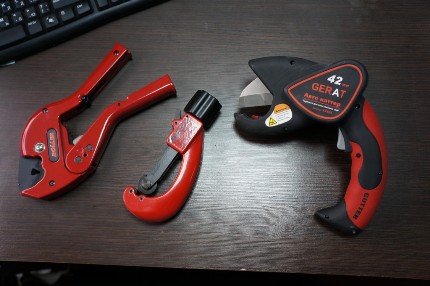
When choosing equipment for cutting polypropylene pipes, the main attention should be paid to two points:
- The blade must be made of alloy steel.
- Each pipe cutter model has two indicators - the minimum and maximum pipe size. This range should be selected so that it is enough to carry out the work.
The case material of such equipment is usually made of metal. And best of all, when it's aluminum, not steel. The pipe cutter with aluminum handles is light in weight, it will take less effort to work. Soft polypropylene pipes when cutting do not require excessive effort. The aluminum tool will cope with the arising loads without problems.
The pipe cutter can have replaceable or non-replaceable cutters. Sooner or later they will wear out. In the second case, the tools will have to be bought again.However, if the cutting apparatus is needed for one-time work, then it is better to take a cheaper model with non-replaceable equipment.
Option # 1 - Guillotine
The simplest in design and accurate in cut quality pipe cutting equipment is guillotine shears. They can be manual and electric. Structurally, this is a blade descending onto a pipe made of polypropylene, which makes a cut that is even and strictly perpendicular to the longitudinal line.
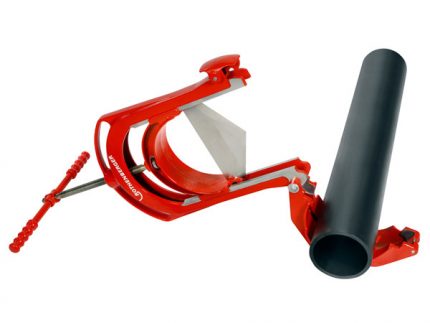
Most of the manual guillotines are designed for cutting pipe products with a cross section of up to 70 mm. But some models are subject to diameters of 100-150 mm. This is quite enough to perform installation work at home. All of the above applies already to industrial equipment.
The knife as it is pressed onto the soft polypropylene easily rips it off. In this case, pipe deformations do not occur due to the sharpness of the Teflon-coated cutter and the smoothness of its movement. After the polypropylene cut, additional processing to the end face is no longer required. The pipe is completely ready for butt welding and using fittings.
The only drawback of the guillotine, which is worthy of mention, is the low speed of work. Each time, the blade must be returned to its original position by prolonged twisting of the rod. But on the other hand, the cut is perfectly even, and for this you can twist the handle. However, if it is planned to cut a lot of polypropylene pipes, it is better to choose a different type of pipe cutter.
Option # 2 - Ratchet
This class of pipe-cutting tool in shape resembles ordinary scissors with two handles. Only the blade on one side. The second half is made in the form of a semicircular emphasis, where the pipe should fit when cutting.
They are equipped with a ratchet mechanism (ratchet) so that the knife moves smoothly, and at the same time efforts have to be applied to a minimum.

The main disadvantages of this cutting equipment are the high probability of obtaining an oblique cut and possible collapse of the pipe. In fact, these are large manual scissors. You need to use them skillfully. Our site has a detailed article on how to use this type of pipe cutter. More details - go link.
By inexperience, the slightest tilt in their hands leads to the formation of a curved end, which then has to be grinded. And if the pipe is also crumpled, then it will need to be straightened from the inside by a calibrator.
The same type includes pistol pipe cutters with ratchet mechanism. They are much easier to work with. Efforts for cutting have to be made very little, and the cut is more even.
The knife returns to their original position as a result of pressing the button due to the spring. This is the best option for cutting polypropylene pipes with thicker and harder walls.
Option # 3 - Roller
The next type of pipe cutter is roller. He has one or more rollers in his design. This tool looks like a hook. Inside this hook are movable wheels on which the cut pipe rests.
The cut itself is made by another already cutting roller-knife, extended from the handle on a telescopic extension.

Polypropylene cutting occurs as a result of rotation of the roller pipe cutter around the pipe clamped in it. It is important to rotate it so that the cut line in the plastic does not go away from the starting point.
The cutting roller should end the circle in the same place where it started. If the pipe walls have to be cut thick, then the revolution around the pipe will need to be done several times, gradually pressing the cutter deeper into the plastic by turning the screw on the handle.
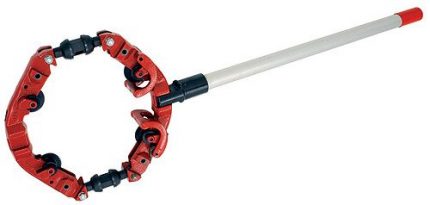
With proper use and precise holding of the knife along the cutting line, the result of using a roller pipe cutter is perfectly smooth. By this indicator, it is comparable to the guillotine.
But he cuts pipes much faster, however, and costs more. Plus, the slightest inadvertent shift of the knife to the side leads to the appearance of burrs in the place of cut, which are subject to further removal.
When cutting polypropylene with a roller pipe cutter, do not over tighten the handle, pressing the blade disc to the surface to be cut too much. Microcracks can form in the plastic, which will reduce the strength of the pipe and can lead to chips on the end.
Everything should be done smoothly and slowly. This is especially true for work with thick-walled and large-diameter sewer pipelines.
What and how not to cut polypropylene?
In addition to the above specialized pipe cutters, polypropylene pipes can be cut into:
- hacksaw;
- jigsaw in slow motion;
- inside with a drill with a disk nozzle.
One "BUT". The edges of the pipe as a result of using these “improvised” tools are torn. This is not only ugly, but also unacceptable.
Before soldering the pipe ends must be cleaned of all burrs and aligned, otherwise the connection will turn out to be fragile. Such aggressive cutting almost always leads to problems on the installed pipeline in the future.
Using a grinder is not recommended. Due to the high speed of rotation of its disk, the polypropylene pipe will begin to heat up and melt. A similar situation can occur when using an electric jigsaw, if you turn it on at full power.
Use these tools to cut plastic should only be a last resort, when there is nothing else at hand.
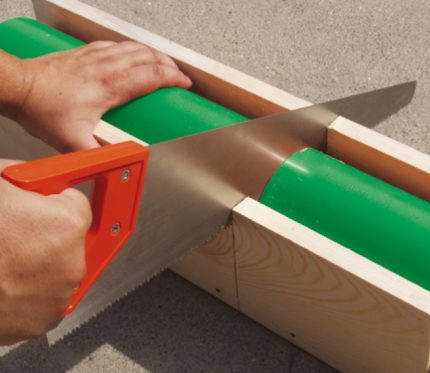
Regardless of the tool chosen, it is impossible to press them strongly on the polypropylene pipe when cutting. This applies to the use of both the grinder and professional pipe cutters.
Efforts should be increased gradually, otherwise the plastic may simply crack. With strong pressure in the pipe walls of PP, invisible damage to the eye can occur, which will then lead to a rupture of the pipeline.
There is another argument against the strong pressure of the cutting tool on the polypropylene pipe - deformation in terms of geometry. The walls in the place of such pressure begin to slip, because of which a section in section from a circle turns into an oval. And the butt for welding with the fitting should be perfectly round. You will have to straighten it then with a calibrator, which will take time and effort.
To prevent bending of the walls, a pair of round bars of wood of slightly smaller diameter should be inserted into the pipe to be cut. The knife will have to pass between them when cutting polypropylene. So the plastic does not exactly bend, but cuts as it should.
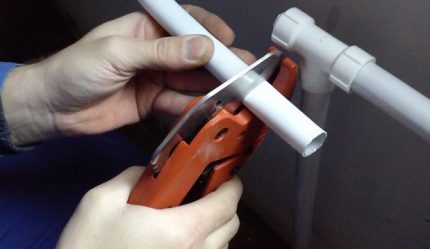
Categorically it is not necessary to use a band saw or a circular saw for cutting. Polypropylene is too soft and too fragile for them. On the one hand, the pipe can be pulled out of the hands, and on the other, without chips and cracks in the place of the cut, it certainly will not do.
Apply for cutting pipe cutters designed for metal pipesis also not recommended. Their knives are made of another material with slightly different characteristics.
They will not cut plastic, but tear. An exception is only universal tools for all types of pipelines. But they cost a lot, this is more an option for professional plumbers.
Chimney cutter selection - mechanical vs electric
In everyday life for one-time work, it is recommended to use a manual cutting tool. It costs less than electric and is easier to use.
If you need to make several cuts for installing a water supply system in a private house or apartment on a site from a riser to any plumbing, then this is just the perfect choice.However, with large volumes of work effort and time for cutting pipes, it will take a lot.
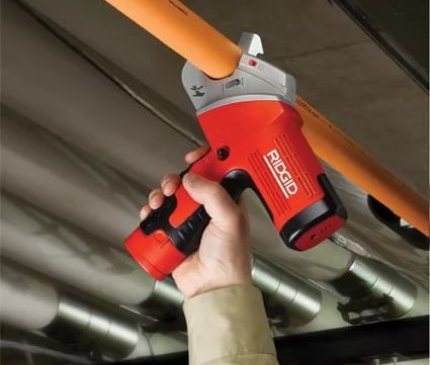
Electrical equipment will cost more than a mechanical counterpart. But it greatly facilitates and accelerates the process of cutting polypropylene pipes. The edges are more even as a result. In this case, it is not necessary to exert effort to press the handle, you just need to hold the electric pipe cutter exactly along the cutting line. Errors are virtually eliminated.
Any power tool requires power to operate. If there are problems with this (electricity is not yet connected to the newly built house or accidents are constantly happening), then it is better to prefer a manual pipe cutter. We will have to work hard and make efforts, but the installation of the water supply and sewage system will be completed on time without delay.
The manual pipe cutter is compact in size. Often, a cumbersome electrical analogue to bring to an already mounted pipeline to make an insert into it is simply impossible. But with manual scissors, to perform such an incision will turn out without problems.
An alternative to both of these pipe cutter options is electrical equipment with a removable battery. A similar tool weighs only 1.5–2 kg. The electric drive facilitates the cutting process, but you do not have to look for a socket for connecting such “scissors”. The battery is usually enough for a couple of hundred cuts, which is enough for a full-time work.
Conclusions and useful video on the topic
In order for the pipeline assembly to succeed, the tool for cutting pipes from polypropylene must be selected correctly. Not every pipe cutter is suitable for such a job.
They still need to learn how to use, after having tested it on an unnecessary piece of pipe. The video reviews below will surely help you navigate choosing this equipment.
Overview of various shears for cutting polypropylene pipes:
Comparison of different methods of cutting pipes from plastic:
How to use the ratchet pipe cutter:
It is difficult to install a polypropylene pipeline without a pipe cutter in your hands; cutting pipes will take a lot of time. You need to purchase one or another version of the cutting equipment. However, you should choose it in the store correctly. And before the operation, it will not hurt to carefully study the operating rules attached to the tool, nevertheless it is a specialized professional tool.
Looking for a pipe cutter for home use? Or already have experience with similar equipment? Please leave your comments, share experiences, ask questions on the topic of the article in the block below.

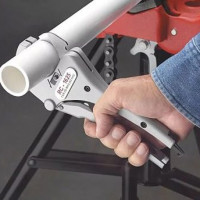 Scissors for cutting polypropylene pipes: species overview + instructions for use
Scissors for cutting polypropylene pipes: species overview + instructions for use  Pipe cutter for copper pipes: types, selection tips, rules and nuances of use
Pipe cutter for copper pipes: types, selection tips, rules and nuances of use 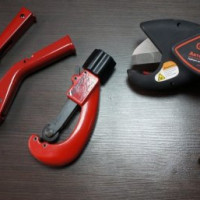 Pipe cutter for plastic pipes: choose the best model + instruction for use
Pipe cutter for plastic pipes: choose the best model + instruction for use 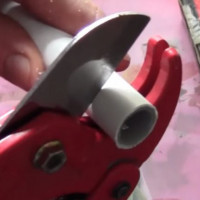 Pipe cutter for plastic pipes: types, which is better to choose and how to use it correctly
Pipe cutter for plastic pipes: types, which is better to choose and how to use it correctly 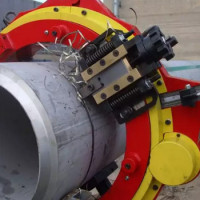 Pipe cutter for steel pipes: types, tips for choosing a model and the nuances of competent operation
Pipe cutter for steel pipes: types, tips for choosing a model and the nuances of competent operation 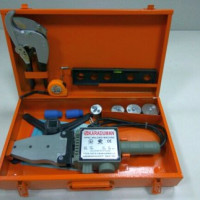 How to choose a soldering iron for polypropylene pipes: tips from professional plumbers
How to choose a soldering iron for polypropylene pipes: tips from professional plumbers  How much does it cost to connect gas to a private house: the price of organizing gas supply
How much does it cost to connect gas to a private house: the price of organizing gas supply  The best washing machines with dryer: model rating and customer tips
The best washing machines with dryer: model rating and customer tips  What is the color temperature of light and the nuances of choosing the temperature of the lamps to suit your needs
What is the color temperature of light and the nuances of choosing the temperature of the lamps to suit your needs  Replacement of a geyser in an apartment: replacement paperwork + basic norms and requirements
Replacement of a geyser in an apartment: replacement paperwork + basic norms and requirements